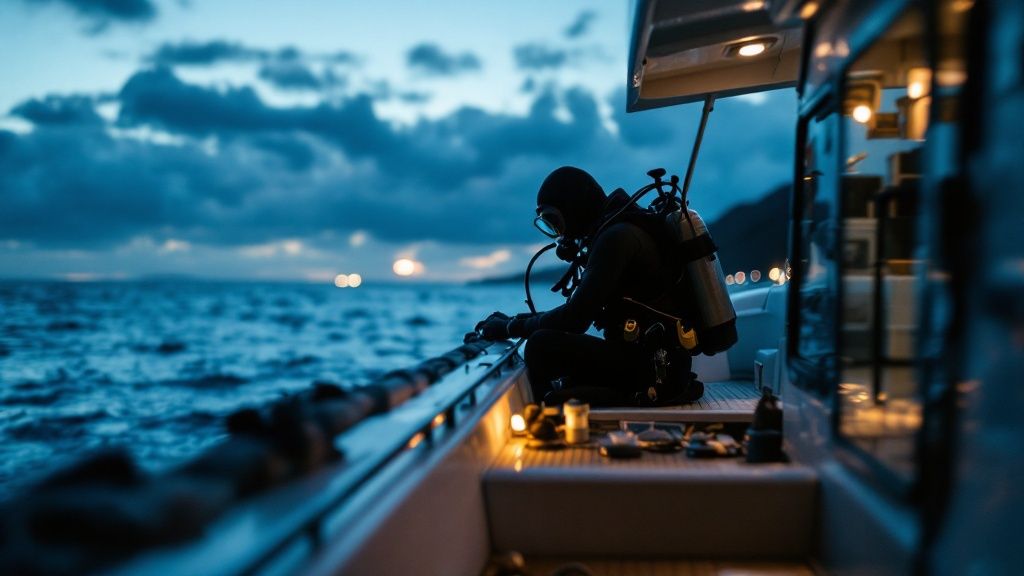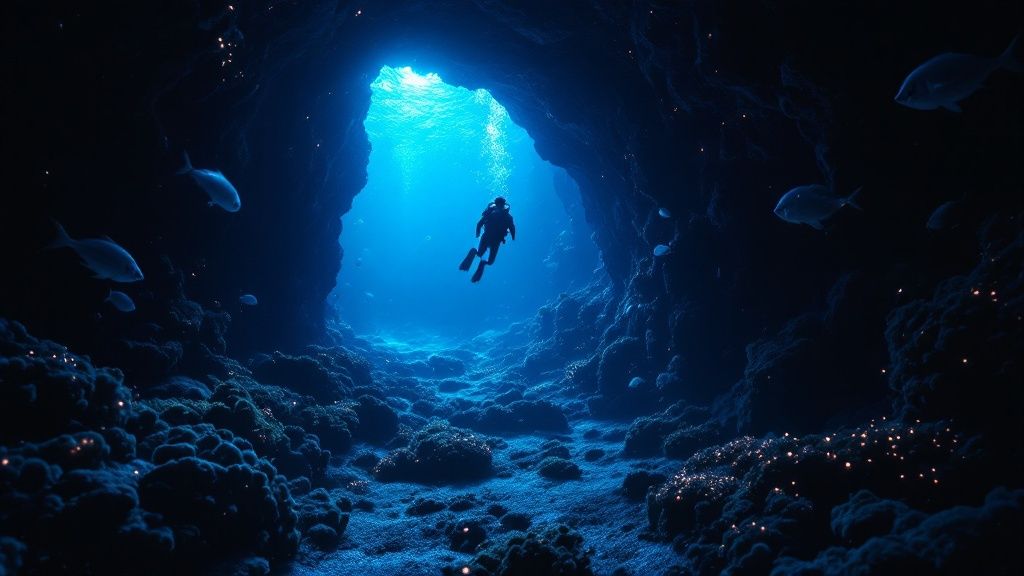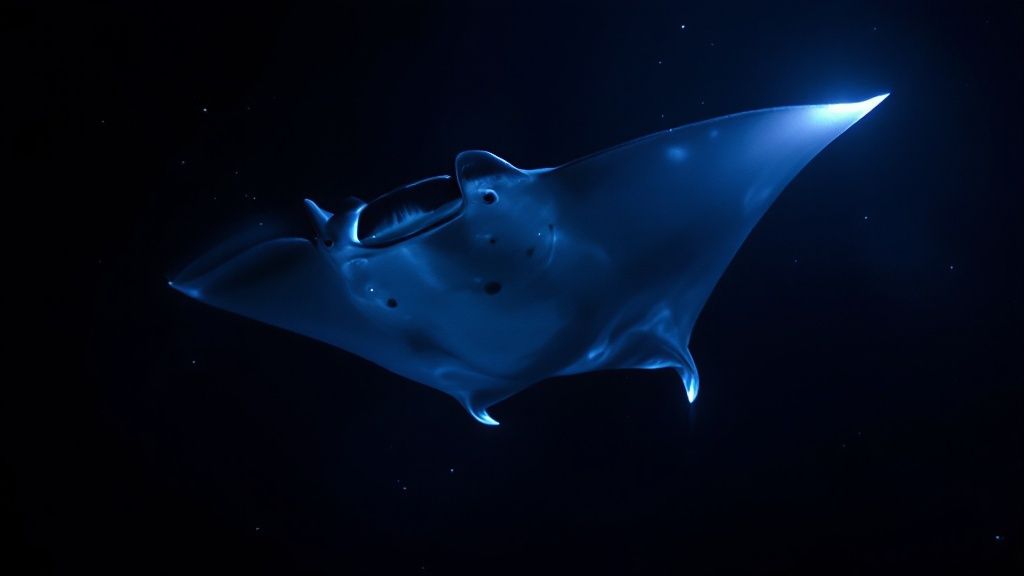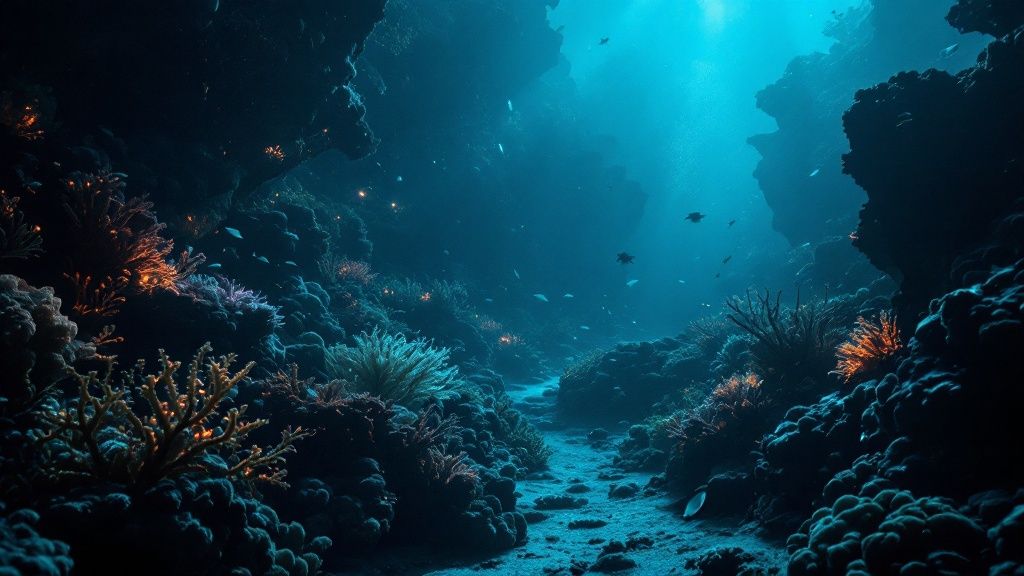The Mesmerizing World of Kona’s Manta Ray Night Dives
Imagine yourself floating in the dark depths of the Pacific Ocean, guided only by the gentle beams of dive lights. Suddenly, a graceful giant appears – a manta ray, its wingspan wider than a car, moving effortlessly through the water. This is the magic of a manta ray night dive in Kona, Hawaii, an experience that draws underwater enthusiasts from around the globe.
These dives offer more than just a brief encounter with a magnificent creature. They provide a deep immersion into a truly unique ecosystem. Kona’s waters offer the perfect combination of factors for these incredible interactions, a blend rarely found elsewhere. The interplay of darkness, artificial light, and fascinating marine biology creates a captivating display, often turning first-time divers into lifelong fans.
This enchanting dance between divers and manta rays began relatively recently. Manta ray night dives first gained popularity around 1991 near the Kona Surf Hotel. When the hotel eventually closed, dive operators discovered another manta feeding ground north of Kona, near the airport, at a site now known as Garden Eel Cove. Today, this spot is famous for its consistent manta ray sightings, with nearly 200 identified individuals. The Manta Pacific Research Foundation plays a vital role in identifying and monitoring these gentle giants. They use unique belly patterns to track the manta ray population and assess their health. You can learn more about this research here.
The Allure of the Night Dive
What makes the Manta Ray Night Dive Kona Hawaii so special? The experience transcends simple observation; it creates a deep sense of connection with these gentle giants. Divers often speak of a feeling of awe and peace as the mantas perform their underwater ballet just inches away. This close proximity, combined with the dreamlike quality of the nighttime ocean, makes for an unforgettable experience.
The darkness itself is key to the magic. It amplifies the effect of the dive lights, attracting plankton, the manta rays’ main source of food. This creates a “campfire” effect, drawing the mantas closer to the surface. Here, they perform captivating feeding loops, mesmerizing divers with their graceful movements. It’s not simply about seeing these creatures; it’s about experiencing their natural behavior in a truly remarkable setting.

A Transformative Underwater Experience
The emotional impact of a manta ray night dive is powerful. Many divers describe a profound sense of wonder and tranquility, calling the experience life-changing. These encounters foster a greater appreciation for the delicate balance of the ocean and the vital importance of protecting these amazing animals. The experience often sparks a desire to learn more about manta rays and contribute to their conservation. This transforms a Kona manta ray night dive from a simple adventure into an opportunity for connection, education, and inspiration.
Up Close With Kona’s Magnificent Marine Ambassadors
Beyond their impressive wingspans, manta rays are captivating ocean creatures with a wealth of fascinating behaviors and characteristics. Underwater observation and scientific study reveal how these intelligent filter-feeders have adapted unique feeding strategies specifically for Kona’s night environment.
Identifying Individual Mantas
One of the most rewarding aspects of a manta ray night dive in Kona, Hawaii is learning to identify individual mantas. Each manta has a unique spot pattern on its belly, much like a human fingerprint. This allows researchers and divers to distinguish between individuals and even give them names like “Big Bertha,” a well-known manta in the area. This personal touch transforms a simple sighting into a meeting with a familiar friend.
The Graceful Ballet of the Sea
Manta rays are often called the “ballerinas of the sea” due to their incredibly graceful movements. Effortless glides, somersaults, and pirouettes characterize their feeding behavior. This elegant dance is enhanced by the darkness of the nighttime ocean, illuminated by dive lights attracting plankton. The manta ray population thrives in Kona’s waters, with estimates of over 300 mantas frequenting the area. These gentle giants can reach up to 15 feet wide and weigh as much as 3,000 pounds, feeding on the billions of plankton attracted to the lights. Learn more about Kona’s manta rays here.
Understanding Manta Intelligence and Social Behaviors
Manta rays possess surprising intelligence, with complex social behaviors and interactions that continue to intrigue scientists. While much remains unknown, observations suggest a high level of social awareness. They display intricate communication and potentially cooperative hunting strategies, hinting at a deeper cognitive ability yet to be fully explored.
Kona’s Nighttime Feeding Strategies
Manta rays have developed specialized feeding strategies perfectly adapted to Kona’s night environment. Dive boat lights create a concentrated plankton source, drawing in large numbers of mantas. They employ various feeding techniques, like barrel rolling and chain feeding, maximizing their plankton intake. This adaptation highlights the interplay between human activity and natural behavior, creating a remarkable wildlife spectacle. This understanding transforms a simple dive into a meaningful connection with these magnificent marine ambassadors.

Prime Locations for Unforgettable Manta Encounters
Not all manta ray night dive sites in Kona, Hawaii are created equal. While the Kona coast is renowned for these incredible encounters, subtle differences between locations can significantly impact your dive. Drawing on insights from local operators with years of experience, we’ll explore Kona’s top manta ray viewing spots. This insider knowledge will help you choose the perfect location for an unforgettable Manta Ray Night Dive Kona Hawaii.

Garden Eel Cove (Manta Heaven): The Gold Standard
Garden Eel Cove, often called Manta Heaven, is a prime location for manta ray night dives. Its consistent manta ray activity makes it a favorite for both experienced divers and first-timers. The sandy bottom, surrounded by coral reefs, creates an ideal environment for plankton, attracting the mantas who feed on these microscopic organisms. The relatively shallow depth also contributes to excellent visibility, enhancing the already spectacular views.
Manta Village: A Unique Perspective
Manta Village, located in Keauhou Bay, offers a different but equally captivating experience. The bay’s sheltered waters provide calm conditions, perfect for those prone to seasickness or new to night diving. This location is known for attracting diverse manta rays, sometimes including larger individuals like the famous “Big Bertha.”
To help you compare these popular sites, and a few others, take a look at the table below:
To help you choose the best dive site for your experience level and interests, we’ve compiled a comparison table of Kona’s top manta ray dive locations. This table highlights key features of each site, including average depth, ideal diver experience level, and manta sighting rates.
| Dive Site | Location | Average Depth | Best For | Manta Sighting Rate |
|---|---|---|---|---|
| Garden Eel Cove (Manta Heaven) | Kona Coast | 30-40 ft | All Levels | Very High |
| Manta Village | Keauhou Bay | 20-30 ft | Beginners & Families | High |
| Stone Quarry | South Kona | 40-50 ft | Experienced Divers | Moderate |
| Kohanaiki | North Kona | 30-40 ft | Intermediate Divers | Moderate |
As you can see, each site offers a unique experience. Whether you’re a beginner looking for calm waters or an experienced diver seeking a deeper dive, Kona has a manta ray dive site for you.
Exploring Lesser-Known Spots
While Manta Heaven and Manta Village are the most popular sites for the Manta Ray Night Dive Kona Hawaii, Kona offers lesser-known locations for more intimate encounters. These hidden gems might require a bit more searching but can reward you with a unique experience away from the crowds. Some operators offer dives further north along the coast, where you might find smaller groups of mantas in a more secluded setting. This provides a more personal and less crowded experience.
The Subtle Environmental Factors
Several environmental factors influence the quality of a manta ray night dive. Currents play a vital role in distributing plankton, the mantas’ primary food source. Stronger currents bring more plankton, increasing manta ray activity. The bottom composition also affects the type and abundance of plankton. Sandy areas like Garden Eel Cove support different plankton communities than rocky reefs. Mantas are sensitive to these variations and choose feeding areas accordingly. Proximity to deeper waters also matters. Sites closer to deeper channels or slopes often have increased manta ray activity as these areas serve as migratory routes and access to nutrient-rich waters.
Understanding these subtle differences helps you select the perfect venue for your manta ray night dive Kona Hawaii adventure. Choosing the right location based on your experience level, goals, and preferences ensures an unforgettable encounter with these graceful giants.
From Booking to Bubbles: Planning Your Perfect Dive

Turning the dream of a manta ray night dive in Kona, Hawaii, into a truly memorable adventure starts with good planning. This guide, crafted with insights from experienced Kona dive operators, covers everything from selecting the perfect operator to knowing what awaits you back on dry land.
Choosing a Reputable Operator
Picking the right tour operator is essential for a safe, ethical, and enjoyable manta ray night dive. Seek out operators, like Kona Honu Divers, who prioritize both your experience and the well-being of the mantas. Kona Honu Divers stands out with excellent reviews and numerous accolades.
Sustainable practices and adhering to guidelines set by organizations like the Manta Pacific Research Foundation should be top priorities. Smaller group sizes often lead to a more personal and less disruptive encounter with these magnificent creatures.
For instance, Kona Honu Divers emphasizes small groups, meaning less crowding around the manta rays and a more tailored experience for each diver. Watch out for red flags such as overcrowded boats and operators who disregard manta ray safety protocols. This ensures your dive supports conservation, not harm.
Understanding Tour Packages and Seasonal Considerations
Knowing what’s included in different tour packages is key to a great manta ray night dive in Kona. Some tours cover basic equipment rental, while others include wetsuits and even underwater photography options. Some operators also offer snacks or meals, a welcome treat after an exciting dive.
Clarify what each package offers to avoid unexpected costs and plan your budget accordingly. Beyond packages, the time of year and the moon phase can significantly impact your dive. While manta rays are present all year, the calmer waters of the dry season (April to October) typically offer better visibility.
The moon also plays a role, affecting the ambient light and how the mantas appear under the dive lights. A new moon enhances the dramatic effect of the lights and attracts more plankton, creating a mesmerizing “campfire” effect. A full moon might provide better overall visibility, but the “campfire” effect is less pronounced.
Addressing Practical Concerns: Seasickness, Water Temperature, and Skill Level
Concerns about seasickness, water temperature, and required skill levels are common. Addressing these upfront ensures a more comfortable and enjoyable dive. Many operators, like Kona Honu Divers, provide seasickness remedies. It’s also a good idea to take motion sickness medication beforehand.
Wetsuits are usually provided and highly recommended, even in warmer months, as water temperatures can cool down after sunset. Both certified divers and snorkelers can experience the magic of manta ray night dives. Snorkeling offers a surface view, while scuba diving provides a deeper, more immersive perspective.
Kona Honu Divers caters to both, allowing everyone to partake in this amazing experience. Choose the option that best suits your comfort and skill level for maximum enjoyment.
To help you visualize the differences, here’s a handy comparison table:
Diver vs. Snorkeler Experience
Comparison between the diving and snorkeling options for manta ray night encounters
| Experience Aspect | SCUBA Diving | Snorkeling |
|---|---|---|
| Depth | Deeper, closer to manta rays | Surface level |
| Perspective | Immersive, 360-degree view | Looking down from above |
| Equipment | Requires specialized equipment (tanks, regulator, BCD) | Mask, snorkel, and fins |
| Skill Level | Certification required | No certification needed |
| Physical Exertion | More demanding | Less strenuous |
This table highlights the core differences between the two options, letting you pick the experience best suited for your needs and abilities. Ultimately, both offer a unique and unforgettable way to witness the beauty of manta rays.
Preparing for the Dive: What to Expect
Knowing what to expect before, during, and after your dive can enhance the entire experience. Most operators give a pre-dive briefing covering safety procedures, manta ray etiquette, and what will happen in the water.
This often includes instructions on handling the light boards used to attract plankton (and the mantas) and how to interact responsibly with these gentle giants. Once in the water, divers and snorkelers usually hold onto a submerged board or float equipped with lights.
These lights attract plankton, and the mantas gracefully glide and loop through the illuminated area to feed, providing spectacular close-up views. Remember to stay calm and avoid touching the mantas, as this can disrupt their feeding and potentially harm them.
After the dive, most operators offer warm drinks and a chance to swap stories. This shared experience creates a sense of wonder and underscores the importance of manta ray conservation.
Protecting What We Love: Conservation in Action
Behind every sustainable manta ray encounter is a dedicated team working to protect these graceful creatures. Scientists, dive operators, and informed visitors like you are all part of this vital network. Organizations like the Manta Pacific Research Foundation are leading critical conservation efforts in Hawaiian waters. These efforts are important not only locally, but globally, given threats like the demand for manta ray gill plates, which fuels hunting in other areas of the Pacific.
Protecting manta rays in Kona is a priority because of their worldwide vulnerability. The Manta Pacific Research Foundation tirelessly studies mantas in their natural habitat, conducts scientific research, and educates the public. The growing demand for gill plates, driving hunting elsewhere in the Pacific, underscores the importance of local conservation work. Dive operators strictly enforce guidelines set by The Ocean Recreation Council of Hawaii and PADI’s Project AWARE to protect the mantas’ health during these dives. Learn more about manta ray conservation here.
Tracking Mantas: Understanding Individuals and Populations
A key part of conservation involves tracking systems. Researchers use the unique spot patterns on each manta’s belly, like a fingerprint, to identify and monitor individual animals. This helps them track movements, learn about population dynamics, and assess the overall health of the manta ray population. The data provides important insights into the long-term health and sustainability of the manta ray population.
Minimizing Human Impact: Best Practices for Sustainable Encounters
Best practices are constantly evolving to minimize human impact on manta rays during night dives. Reputable operators, such as Kona Honu Divers, strictly follow established guidelines, ensuring the mantas’ safety and well-being. These guidelines include maintaining a respectful distance, avoiding touching the mantas, and managing light usage to minimize disruption.
Sustainable Tourism: Balancing Visitor Experience With Marine Protection
Leading operators are adopting sustainable tourism practices. They’re finding the right balance between creating unforgettable visitor experiences and protecting these gentle giants. This involves limiting group sizes to minimize crowding and stress on the mantas. It also includes educating divers about responsible behavior and supporting research and conservation projects.
How You Can Help: Making a Difference Before, During, and After Your Dive
You can play a vital role in manta ray conservation. Before your dive, choose operators committed to sustainable practices. During the dive, follow your guide’s instructions, respect the mantas’ space, and refrain from any actions that could disturb them. After your dive, share the importance of manta ray conservation and support dedicated organizations.
Kona Honu Divers: A Model for Sustainable Practice
Kona Honu Divers are a model for responsible manta ray night dive operations. They emphasize small groups for a more intimate experience, lessening the impact on the mantas. Their adherence to guidelines and commitment to diver education demonstrate their dedication to conservation. Choosing operators like Kona Honu Divers directly supports the long-term survival of these amazing creatures.
A Legacy for Future Generations
By working together – scientists, operators, and visitors – we can help ensure the wonder of the manta ray night dive in Kona continues for generations to come. Every responsible dive supports conservation, protecting these gentle giants and their delicate environment. This shared commitment helps ensure these captivating animals will continue to thrive, creating unforgettable memories for future divers and snorkelers.
The Night Dive Experience: From Entry to Encounter
Stepping off the boat and into the dark Pacific Ocean for a manta ray night dive in Kona, Hawaii is an exciting experience. This section walks you through a typical manta ray night dive, from the initial boat ride to the first encounter with these graceful creatures, sharing stories from divers who have witnessed this underwater wonder.
Setting the Stage: The Boat Ride and Pre-Dive Briefing
The adventure begins with a boat ride to a popular Kona manta ray viewing site, like Manta Heaven or Manta Village. Anticipation builds as you approach the dive site. The dive operator will then conduct a pre-dive briefing covering important safety procedures, manta ray etiquette, and a general overview of the dive. They will explain how the “campfire” of lights attracts plankton, which in turn draws the manta rays. This helps you understand the unique relationship between human interaction and the natural behavior of these animals.
Entering the Water and Finding Your Position
After the briefing, it’s time to enter the water. Divers typically descend to the bottom or hold onto a submerged board or float, using specialized dive lights. These lights create a focal point, attracting plankton and the manta rays that feed on them. Snorkelers are often provided with pool noodles for flotation, minimizing kicking and ensuring a calm presence in the manta rays’ habitat. Positioning is key: stay close enough to enjoy the show without disrupting the mantas’ feeding patterns.
The Manta Ray Ballet: A Spectacle of Grace and Power
As plankton gathers in the illuminated area, the manta rays arrive. These gentle giants, with wingspans sometimes reaching 10 feet or more, glide effortlessly through the water, performing captivating feeding loops. They often come incredibly close to the divers, creating an unforgettable, up-close encounter. Witnessing these creatures in their natural environment, their graceful movements illuminated against the darkness, is a truly unique experience.
Managing Anxieties and Staying Calm During Close Encounters
Night diving can be a source of anxiety for some, but understanding the process and having coping mechanisms can help. Remember to breathe deeply and relax, as this will improve your buoyancy. Trust the experienced dive guides; they are trained professionals dedicated to your safety and well-being. While these close encounters are awe-inspiring, remaining calm is crucial. Avoid sudden movements and refrain from touching the mantas, which could disrupt their behavior and potentially harm their sensitive skin.
Capturing the Moment: Photography Tips
Many divers want to document their experience with underwater photography. If you bring a camera, ensure it is securely attached. Keep it close to your body to avoid disturbing the mantas, and consider using a red filter to minimize light interference. More importantly, take time to simply observe these magnificent animals. Some dive operators offer photography packages, allowing you to fully immerse yourself in the experience without the pressure of capturing the ideal shot.
Exiting the Water and Reflecting on the Experience
As the dive concludes, you’ll emerge from the water filled with wonder. Many divers describe the experience as life-changing, fostering a deeper appreciation for these gentle giants and the ocean’s delicate ecosystem. Back on the boat, warm drinks and conversation create a shared sense of excitement. This is the perfect time to discuss the encounter and share your experience with other divers. The memories of this magical night dive will undoubtedly last a lifetime. Ready to experience the wonder of a manta ray night dive yourself? Book your unforgettable adventure with Kona Honu Divers today!
